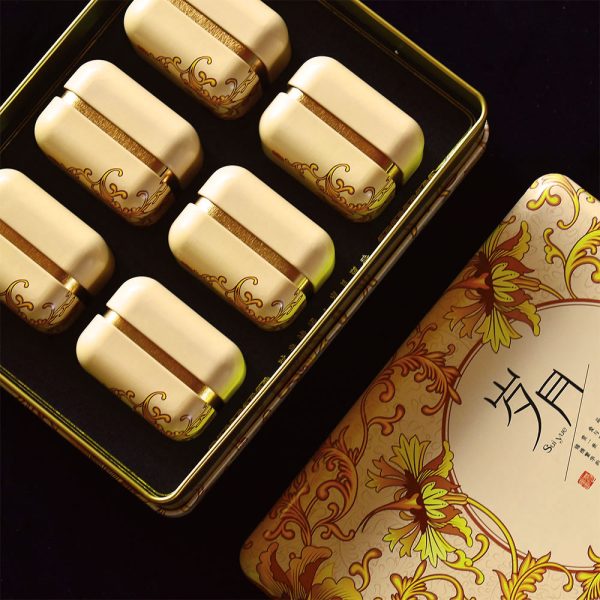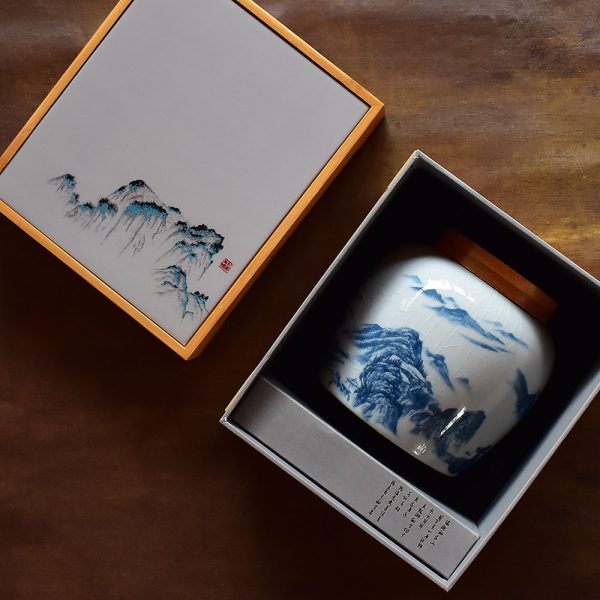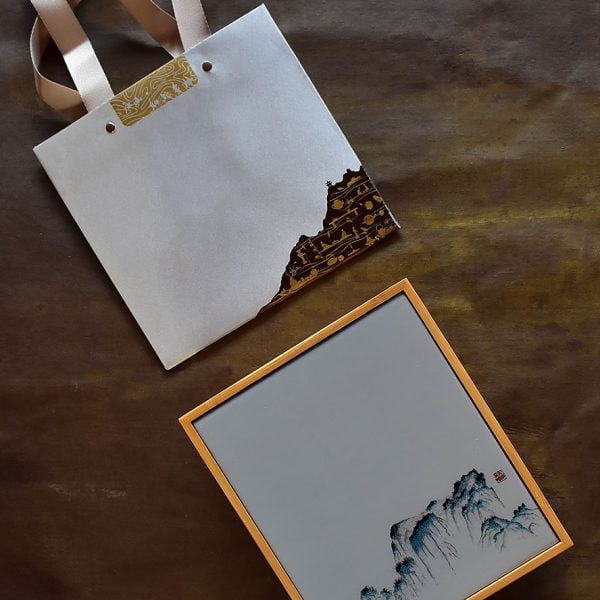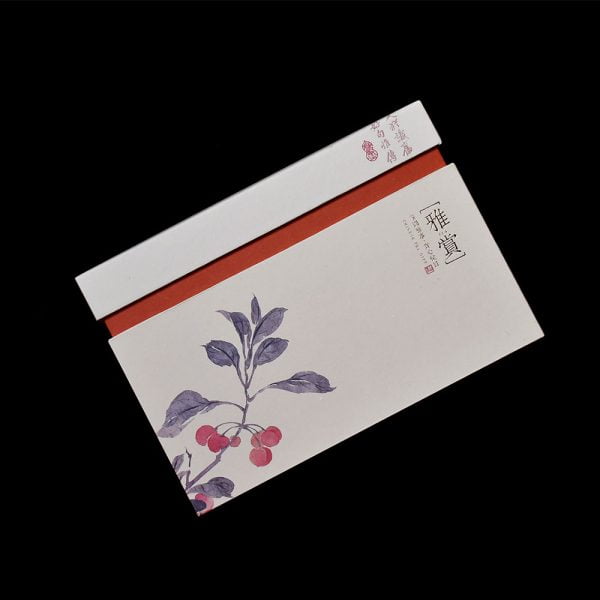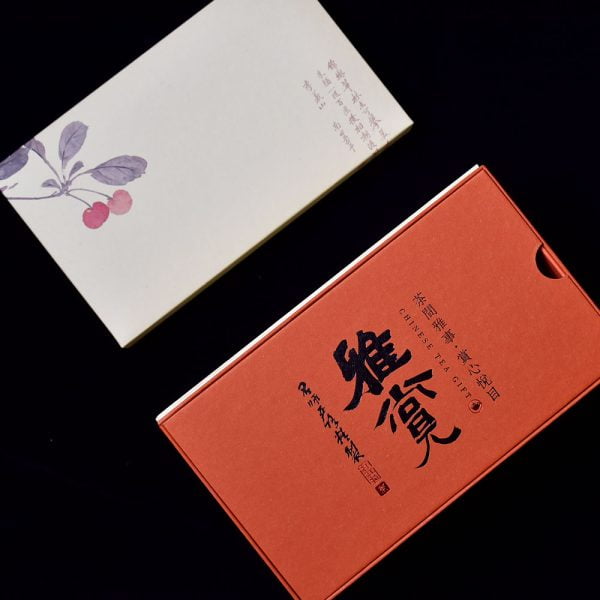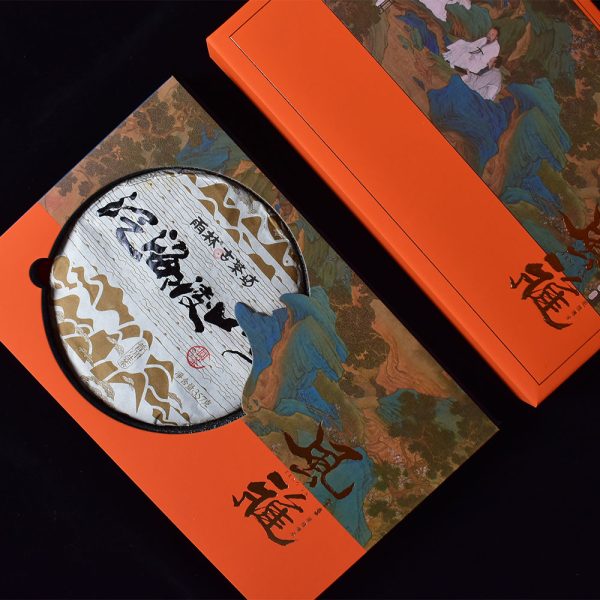Corporate Gifts

Premium & Luxury
Tea Gifts
Elegantly packaged to reflect your brand’s style — because presentation matters as much as the gift itself.
Save the Shipping Fee
Free Delivery
When you order 10+ gifts to a single location.
Your Own Logo & Pattern
Custom Packaging Available
Make it yours — customise any of our tea gifts with your own branding for a truly personalised corporate gift.
Buy Bulk & Save
Volume Discounts
Enjoy greater value when you order in bulk — perfect for large teams, events, or client gifting.
-
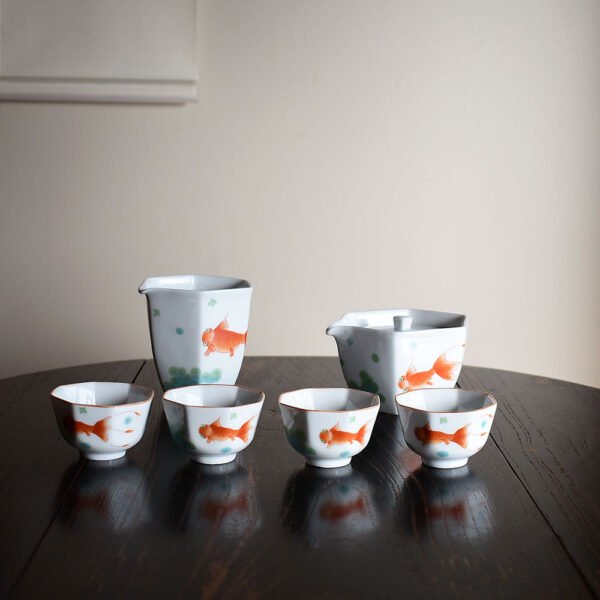
 Out of Stock
$169.99
Out of Stock
$169.99This goldfish set originates from Dehua. The technique used is decal decoration. Decal decoration is one of the most used modern ceramic decoration methods, where coloured patterns from floral paper adhere to the ceramic body or glaze surface. It’s employed for mass production, thus reducing costs and prices.
In traditional Chinese culture, goldfish holds rich symbolism. The similarity in pronunciation between the word for “goldfish” and the phrases “gold” from “金玉满堂” (prosperity and wealth) and “fish” from “吉庆有余” (auspiciousness and abundance) associates’ goldfish with auspiciousness and good fortune. Additionally, the gold colour of the goldfish represents wealth, while the fish’s form symbolizes abundance and contentment in life. Thus, goldfish also embody prosperity and auspiciousness. Furthermore, fish are known for their strong reproductive abilities, and goldfish are no exception. In traditional culture, goldfish symbolize the flourishing and prosperity of one’s family lineage and the hope for many descendants. Beyond this, goldfish also represent academic success. Their graceful and agile swimming is likened to the idea of achieving success and smooth sailing in various endeavours. Lastly, goldfish are associated with attracting wealth and inviting prosperity, making them a common sight in business establishments and home decor, as a way to invite good fortune and financial success.
-
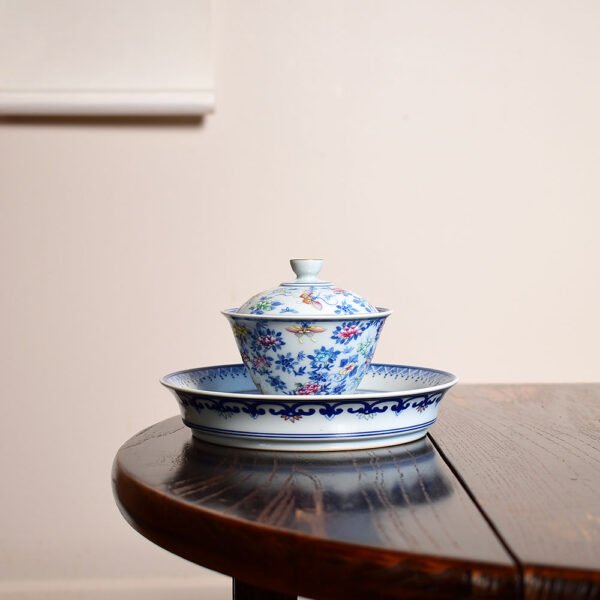
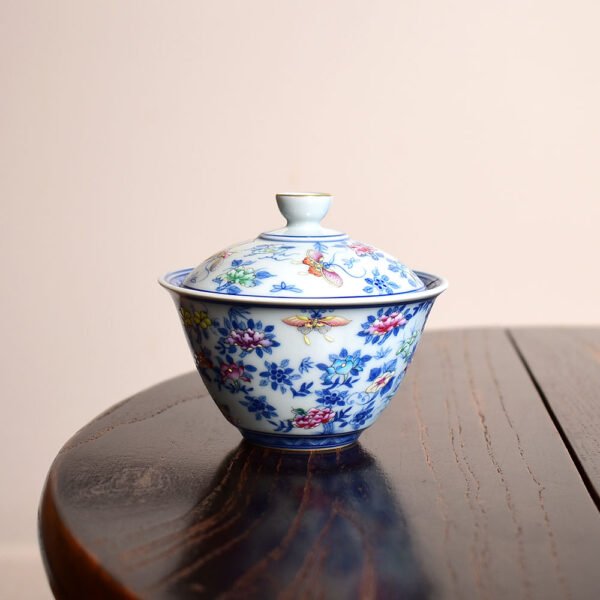 From: $2,168.98
From: $2,168.98This tea set is handcrafted using the technique of Blue-and-white underglaze colour and enamel glazed painting. The design features a pattern of butterflies amid flowers, displaying rich and lifelike colours, creating a unique and charming ambiance.
Blue and White Enamel is a distinctive porcelain decoration technique that combines the traditional methods of blue and white with enamel. It is a variation of the traditional Chinese porcelain production, blending the characteristics of blue and white with enamel, resulting in a captivating and unique decorative style.
Blue and White refers to the technique of painting blue patterns on the porcelain surface. It originated during the Yuan dynasty but reached its peak during the Ming and Qing dynasties. This decorative method uses cobalt oxide blue pigments that fuse with the porcelain surface at high temperatures, ensuring the patterns’ durability.
Enamel, on the other hand, is a decorative technique that involves transplanting the cloisonné enamel method onto a porcelain body as an overglaze colour decoration. Enamel decoration on porcelain, known as “Fàlángcǎi” in Chinese, entails painting colourful patterns on the porcelain surface and then firing it at high temperatures to fuse the colours with the porcelain, achieving a durable and splendid design. These patterns often feature exquisite themes such as flowers, birds, figures, and landscapes, reflecting the essence of traditional Chinese culture and art.
The process of creating enamel decorations is extremely intricate and complex, requiring skilled and experienced craftsmen. First, the porcelain prototype is made, and then special mineral pigments are used to paint patterns on its surface. Once the painting is completed, a series of firing processes follow, during which the temperature and timing for both the porcelain and the enamel colours are crucial factors. Improper temperature or timing can result in cracks in the porcelain or unstable colours. Enamel decoration is considered a treasure in traditional Chinese craftsmanship, representing the wisdom and skills of ancient Chinese artisans.
The combination of blue and white enamel unites these two techniques, typically starting with the blue and white technique to depict blue patterns, and then applying enamel decoration to add additional colours and enhance the visual effect and three-dimensional sense of the design. This decorative method enriches the patterns on the porcelain while preserving the distinctive features of both blue and white and enamel techniques. During the Ming and Qing dynasties, blue and white enamel reached its peak and became one of the main styles for porcelain decoration at that time.
The design on this tea set showcases lifelike patterns of butterflies amid flowers. “Butterflies in Love with Flowers” symbolises sweet love and blissful marriage. In recent times, people have endowed this motif with more profound meanings, expressing good wishes and symbolizing beautiful and prosperous love. Butterflies are often seen as symbols of happiness and love, inspiring and captivating people’s imagination, and aspirations. In traditional Chinese literature, a pair of flying butterflies represents the pursuit of free and passionate love. Butterflies are loyal to their mates, having only one partner throughout their lives, making them a symbol of fidelity in the insect world. Moreover, there is a beautiful Chinese folktale known as “The Butterfly Lovers,” which further enhances the symbolism of sweet love and harmonious marriage associated with the motif of butterflies and flowers.
This enamel-decorated tea set displays a rich and colourful palette, with lively and dynamic brushstrokes, immersing people in an elegant artistic ambiance while enjoying their tea.
This tea set includes:
-

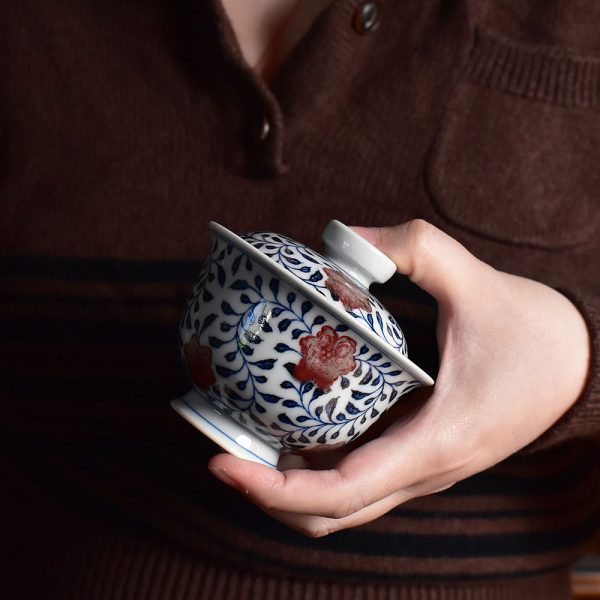 $1,139.99
$1,139.99This Gaiwan and teapot saucer set is entirely handcrafted using the blue-and-white with underglaze red technique. The decoration features the classic “Entwined Lotus” motif.
The entwined lotus pattern — “flowers within flowers, blooms among leaves” — is also known as the “Longevity Vine” in Chinese tradition. It symbolises auspiciousness, and its continuous, interwoven structure conveys the meaning of “endless vitality.” In traditional Confucian culture, the lotus is regarded as the embodiment of truth, goodness, and beauty, and in Buddhism, it is a sacred emblem. The word “lotus” (莲, lián) is a homophone of “continuous” (连, lián), expressing wishes for enduring prosperity. The entwined lotus motif, preserved through centuries of Chinese decorative arts, owes its survival to both its beauty and its rich cultural connotations. The lotus is pure and elegant — beautiful without being gaudy, graceful without being vulgar — making it an enduring symbol in art and daily life.
The blue-and-white with underglaze red technique, known colloquially as “blue and white with purple,” is a porcelain decoration method in which underglaze red is applied alongside blue-and-white patterns. Blue-and-white refers to designs painted with cobalt pigment, covered with a transparent glaze, and fired in a reducing atmosphere above 1200 °C. Underglaze red uses copper oxide (cupric) pigment applied directly to the clay body (or over a base glaze), then covered with a glaze and fired in a strong reducing atmosphere at 1250 °C–1280 °C, producing a vivid yet restrained red. In areas left blank in the blue-and-white pattern, underglaze red may be painted, creating the distinctive combined style.
Producing blue-and-white with underglaze red porcelain is highly challenging. In ancient times, some artisans ruined themselves financially attempting to perfect it. The process requires painting with both cobalt and copper pigments on the same porcelain body, glazing, and firing at high temperatures in a reducing atmosphere. Because cobalt and copper reduce at different temperature ranges, precise control is extremely difficult, and successful pieces are rare. A common flaw is “red bleeding,” where the pigments merge or blur, diminishing clarity.
When executed successfully, this combination of blue, red, and white achieves a striking artistic harmony, elevating porcelain decoration to a new level of refinement.
-
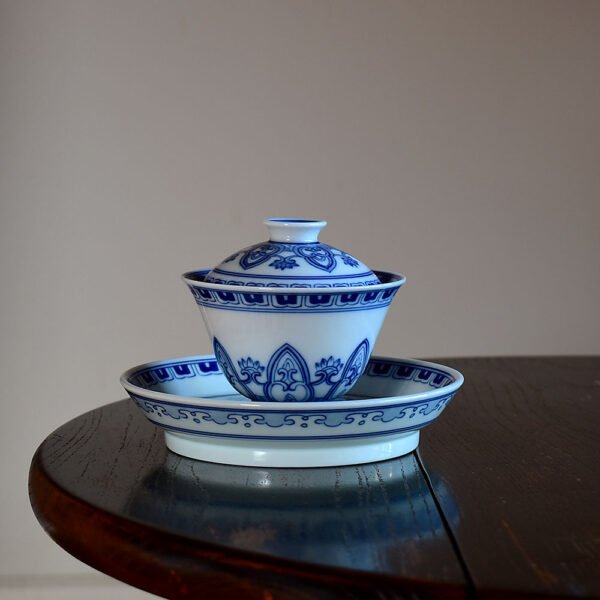
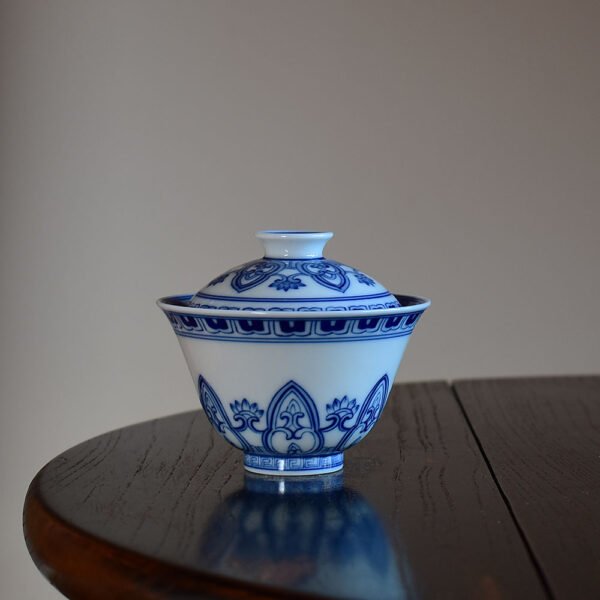 From: $455.98
From: $455.98This tea set is completely handmade and hand-painted. The pattern featured is called “Bao Xiang” in Chinese, which is a traditional decorative motif representing one of the auspicious three treasures (Bao Xiang flower, Money tree, and Treasure basin), prevalent during the Sui and Tang dynasties in China. Bao Xiang pattern is also known as ‘Bao Xian Hua’ or ‘Bao Lian Hua’. Its lines are clear, and the colour is serene and antique. The Bao Xiang pattern design of this teaware is neat, and complex but not messy, and the whole picture of it is full and rich in details.
In Chinese culture, the Bao Xiang pattern symbolizes auspiciousness and happiness, representing people’s aspirations for happiness. It is widely popular in the decoration of silk brocade, bronze mirrors, and porcelain, showcasing people’s pursuit of a better life.
This tea set features smooth and concise curves, combining the unique beauty of the Bao Xiang pattern, creating a visually appealing and enjoyable tea-drinking experience.
This tea set includes:
-

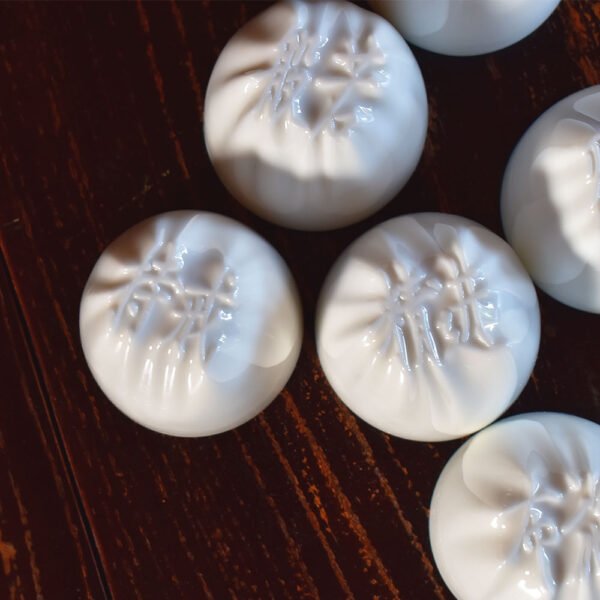 $79.99
$79.99This Zen-inspired gift set features beautiful white jade ceramic teacups, perfect for savouring your favorited brew in a peaceful and serene setting. The cup’s delicate design and high-quality craftsmanship make it a true work of art.
The bottom of the teacup is engraved with the six Buddhist practices, including generosity, ethical conduct, patience, diligence, meditation, and wisdom, allowing you to appreciate the wisdom and compassion of Buddhism while enjoying your tea.
-

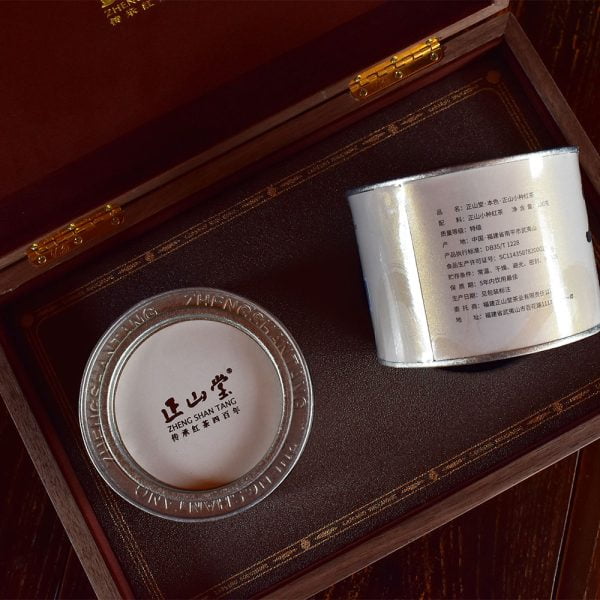 Out of Stock
$309.99
Out of Stock
$309.99This fascinating gift box is from the well-known brand ‘Zheng Shan Tang’, containing 2 x 100g of Zheng Shan Tang Bense Smoked Lapsang Souchong loose leaf tea. Bense Lapsang Souchong is picked from the natural 800 meters in Wuyi Mountain National Nature Reserve and is made with the traditional handicraft of Zheng Shan Tang Souchong black tea.
-

 From: $64.99
From: $64.99Experience the timeless elegance of our Double Tea Tin Ceramic Gift Set, adorned with the exquisite Tang dynasty artwork, “Lady Guoguo’s Spring Outing.” This set is a celebration of fine tea and artistic heritage, perfect for the discerning tea connoisseur. Presented in a sophisticated box adorned with classic Chinese artwork, this gift set captures the essence of ancient traditions and refined taste.
Inside the box, you’ll discover two elegantly crafted ceramic tea canisters. Each canister is finished in a pristine white glaze, embodying simplicity and purity. The canisters are paired with a traditional tea scoop, ensuring you have everything you need to enjoy a perfect brew.
The interior of the box is equally stunning, with a scenic landscape that complements the overall aesthetic. The careful placement of each item within the box ensures that the presentation is as impressive as the contents themselves.
Ideal for gifting or personal indulgence, this Double Tea Tin Ceramic Gift Set promises a delightful and memorable tea-drinking experience, encapsulating the beauty and refinement of Tang dynasty art.
Dimensions:
- Tea Gift Package: 35*23*12.5CM
- Gift Bag: 36*26*14.2CM
- Tea Tin: 11*13.5CM
Gift box alone price: $64.99
-

 $279.99
$279.99This elegant tea set features a serene countryside design and includes a teapot with a “Meiren Jian” (Beauty Shoulder) shape, a fairness pitcher, and four tea cups. Each piece is adorned with hand-painted blue-and-white landscape patterns that depict a tranquil village scene. The flowing river, lush trees, distant houses, and soaring birds evoke a sense of natural harmony and rustic charm.
The teapot stands out with its graceful “Beauty Shoulder” design, where the soft, smooth lines of the shoulder resemble the curve of a beauty’s shoulder, exuding elegance and sophistication. The spout is naturally curved for smooth pouring, while the handle offers a comfortable grip for ease of use. The lid fits seamlessly with the teapot, ensuring that the tea’s warmth and aroma are retained, combining functionality with aesthetic appeal. The tea cups are well-proportioned, with slightly flared rims that enhance drinking comfort while adding a touch of refinement. The fairness pitcher complements the set with its simple and elegant design, creating a cohesive and harmonious style.
The deep and vibrant blue glaze contrasts beautifully with the pristine white porcelain, creating a fresh and refined visual effect. This tea set is not only a practical tool for brewing tea but also a collectible piece that blends traditional craftsmanship with artistic value. Whether for daily use or as a thoughtful gift for friends and family, it reflects both taste and a reverence for cultural heritage.
-
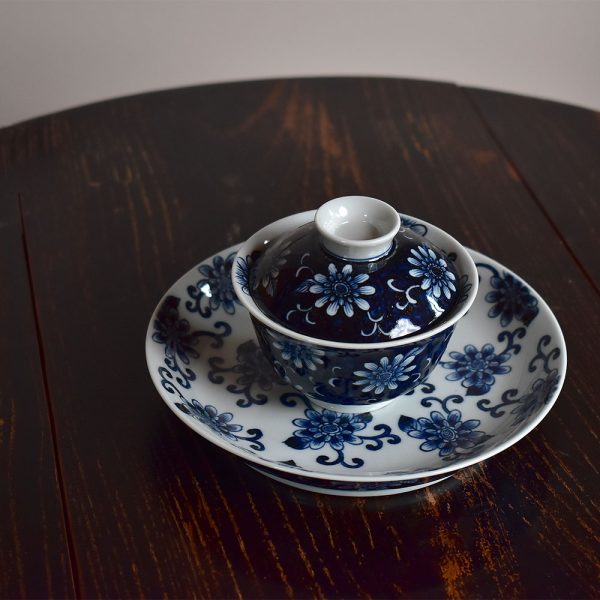
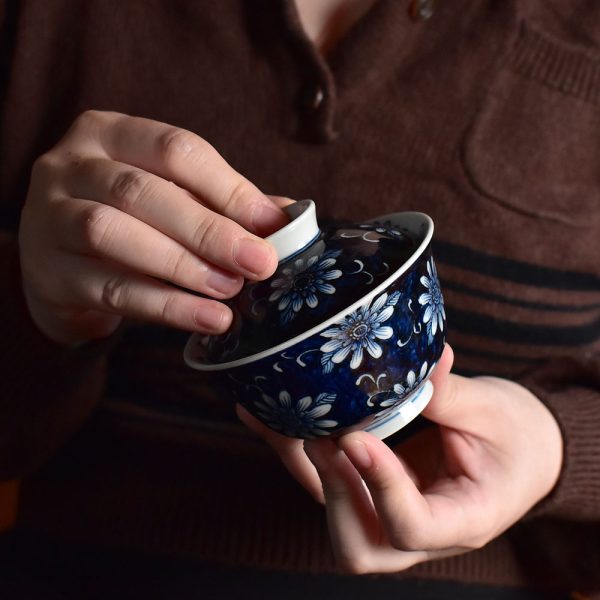 $1,999.99
$1,999.99This Gaiwan and tea tray set features the sunflower motif popular during the Ming and Qing dynasties, with an elegant form and vivid ornamentation. The design incorporates the distinctive silver-spot effect (xi ban) unique to blue-and-white porcelain, creating a visual charm full of antique allure. Entirely hand-painted in underglaze cobalt blue, the decoration offers a rich depth of tone and refined layers.
In traditional Chinese porcelain art, the sunflower symbolises positivity, prosperity, and vitality. Its radiating petals represent light and hope, conveying wishes for a thriving family and a bright future. When used on tea wares, the sunflower carries the additional auspicious meaning of warmth, reunion, and heartfelt connection, enriching the tea-drinking experience with cultural depth.
The Gaiwan’s bowl and lid are adorned with finely detailed sunflower patterns, the petals rendered with both delicacy and strength, and the full blossom centre reflecting the symmetry and order celebrated in Ming and Qing blue-and-white porcelain. Deep cobalt blue backgrounds set off the white-outlined petals, giving the motifs a vivid, dimensional quality. Scattered silver speckles are subtly visible, resembling natural metallic glints that lend a refined, time-worn charm when viewed in the light. The interior walls are similarly encircled by multiple sunflower motifs, creating harmony between inside and out.
The matching tea tray has a broad rim and is fully decorated with sunflowers from the centre to the edge in a dense, well-ordered arrangement. Variations in cobalt shading, combined with the naturally dispersed silver speckles, give the flowers a unique interplay of light and shadow, with a softly weathered texture that reflects the beauty of time’s passage. The base ring is inscribed in blue-and-white script, complemented by floral motifs for a finely crafted finish.
Blending the refined craftsmanship of Ming and Qing blue-and-white porcelain with the symbolic richness of the sunflower motif, this set is equally suited for daily tea rituals, special gatherings, or as a collectible and display piece imbued with auspicious meaning.
-
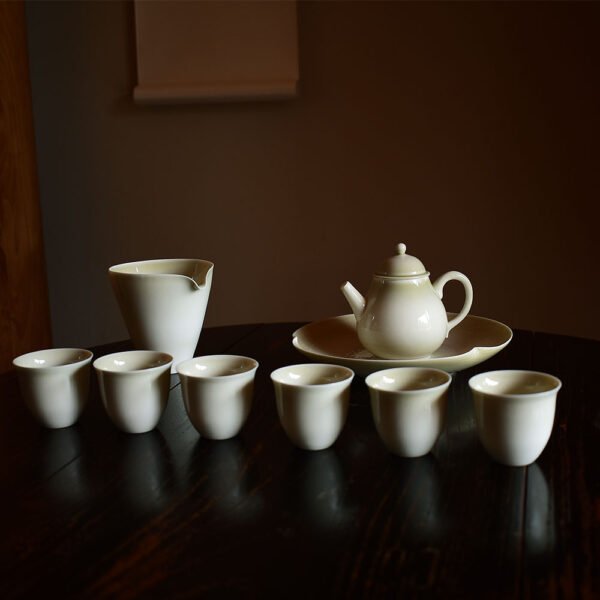
 Out of Stock
$159.99
Out of Stock
$159.99This tea set includes one fair cup, one tea tray, one teapot and six teacups. The special craft used is ash wood glaze. It involves evenly applying wood ash onto the surface of the teaware. At high temperatures, the wood ash melts and forms a glaze, covering the exterior of the tea ware, giving it a faint, natural glaze colour. The effect of the glaze varies based on the type and quantity of ash used, resulting in different shades ranging from greyish-white to light yellow.
Wood ash tea sets are cherished by people for their naturally simple appearance. The glaze typically exhibits delicate textures and a subtle sheen, avoiding excessive extravagance and offering a sense of understated elegance. Its unpretentious and gentle appearance emphasizes the human pursuit and yearning for natural beauty, showcasing a lifestyle attitude that respects nature and seeks inner tranquillity.
-

 $139.99
$139.99This teapot set is a celebration of minimalist design, where every element serves a purpose, and every detail is thoughtfully considered. The wood ash glaze adds a touch of natural beauty, reflecting a deep appreciation for simplicity and elegance. Perfect for those who cherish the art of tea in its purest form, this set transforms any tea ritual into a serene and contemplative experience.
This exquisite tea set features:
- Elegant Minimalist Design: The clean lines and unembellished forms create a timeless aesthetic that enhances any setting. The minimalist approach emphasizes function and beauty, making the set both visually appealing and practical.
- High-Quality Wood Ash Glaze: The unique wood ash glaze not only adds a beautiful, natural finish to each piece but also enhances their durability. The subtle variations in the glaze provide a distinctive, earthy character that is both calming and sophisticated.
- Aesthetic Versatility: The neutral, earthy tones of the wood ash glaze make this set a versatile addition to any decor. Whether placed in a modern, rustic, or traditional setting, it seamlessly blends in while adding a touch of elegance.
- Enhanced Tea Experience: The minimalist design focuses on the essence of tea drinking, allowing users to fully appreciate the color, aroma, and flavor of the tea without distraction. This set transforms the tea ritual into a serene, contemplative experience.
These features make the minimalist wood ash glazed teapot set an excellent choice for those who value simplicity, elegance, and functionality in their tea ware.
-

 $109.99
$109.99Our Apricot White Tea Set is a masterful blend of elegance and minimalism, designed for those who appreciate the beauty of simplicity.
This exquisite tea set features
- Elegant Apricot White Colour: The soft, soothing hue of apricot white adds a touch of sophistication to your tea experience, blending seamlessly with any decor.
- Minimalist Design: Each piece in this set is crafted with clean lines and a sleek, unembellished appearance, reflecting the pure essence of minimalism.
- Simple and Functional: The design prioritizes functionality without compromising on style, ensuring a seamless and enjoyable tea-making process.
Design and Aesthetic
- Elegant Simplicity: The apricot white colour combined with the minimalist design creates a serene and calming aesthetic, perfect for any tea session.
- Timeless Appeal: The set’s understated elegance ensures it will remain stylish and relevant for years to come.
Ideal for Any Setting
Whether you’re enjoying a quiet moment alone or hosting a tea ceremony with friends, this Apricot White Tea Set is perfect for any occasion. Its timeless design and high-quality craftsmanship make it a beautiful addition to any home.
Perfect for Gifting
This tea set makes an ideal gift for those who appreciate the finer things in life. Its elegant simplicity and functional design make it a thoughtful and cherished present.
Experience the beauty of minimalism and the elegance of simplicity with our Apricot White Tea Set, where every detail is designed to enhance your tea-drinking experience.
-

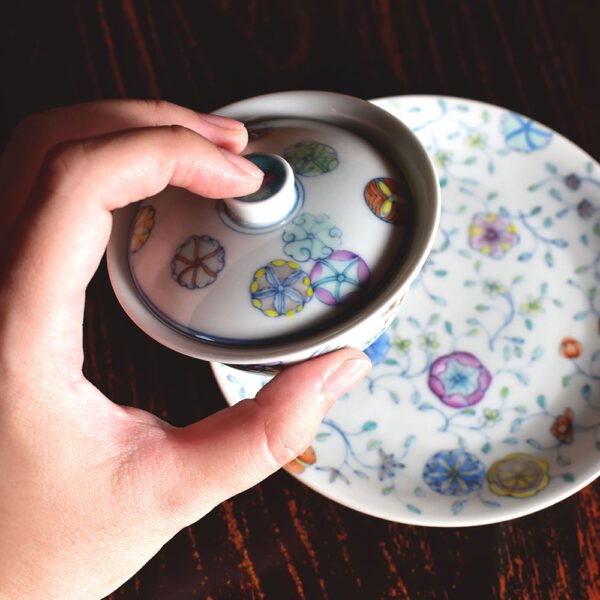 From: $619.98
From: $619.98This small and delicate Dou Cai Pi Qiu Hua teaware set is meticulously crafted with the technique of clashing colour.
As we all know, Doucai is a precious art form in traditional Chinese porcelain craftsmanship. It originated and was fired during the Xuande period of the Ming Dynasty, and Dou Cai from the Chenghua period of the Ming Dynasty is highly esteemed. Dou Cai is a type of decoration that combines underglaze blue (qinghua) and overglaze colour painting.
Dou Cai involves applying mineral pigments onto the previously fired underglaze blue porcelain, filling in the gaps left by the underglaze blue patterns and colouring the space within the outline of the underglaze blue design. The porcelain is then fired in a lower-temperature kiln (800°C). Dou Cai is renowned for its vibrant and varied colour palette, as well as its refined and sophisticated decorative style that reflects the aesthetic taste of the Ming Dynasty.
The decorative pattern of Pi Qiu Hua (皮球花), also known as little tuan hua (小团花) or embroidery ball flower, evolved from the traditional tuan hua pattern on porcelain. This pattern has been present since the Sui Dynasty, and it combines abstract and representational elements. It takes various forms, resembling a spherical shape, hence the name Pi Qiu Hua (皮球花).
The decorative patterns on Chinese porcelain always carry auspicious meanings. Since the Pi Qiu Hua pattern originated from tuan hua, it inherits the traditional tuan hua motifs such as tuan long (团龙), tuan feng (团凤), and tuan hua (团花). These traditional motifs symbolize the abundance and beauty of life.
This beautiful tea set, with its vibrant colours and exquisite craftsmanship, is an eye-catching presence wherever it is placed. Imagine having a cup of spring tea by using this charming tea set, it could be the most delightful experience for a day!
This tea set includes:
-
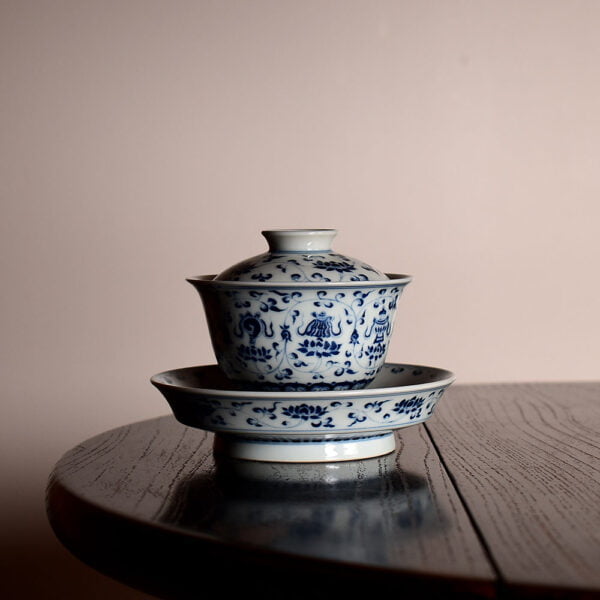
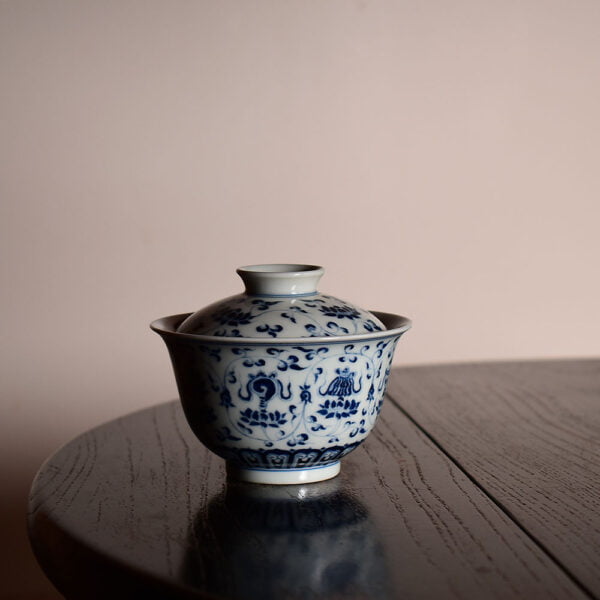 From: $1,695.98
From: $1,695.98The style of this super beautiful tea set is Ming, using the underglaze blue technique, and entirely handcrafted and hand painted. The pattern features very traditional Chinese patterns including intertwining lotus and ‘Ba Bao’.
The “Ba Bao,” also known as the “Buddhist Eight Treasures” or “Eight Auspicious Treasures,” represent eight auspicious objects symbolizing the power of Buddhism. These symbols manifest through the perception of eight types of consciousness: eyes, ears, nose, tongue, body, mind, intellect, and consciousness. They are depicted in various patterns and motifs as decorations in Buddhist art.
During the Qing Dynasty, particularly during the reign of Emperor Qianlong, these eight auspicious symbols were transformed into three-dimensional display items. They were often placed together with ritual vessels in temples. The eight auspicious symbols are abbreviated as follows: Conch Shell, Dharma Wheel, Umbrella, Canopy, Lotus Flower, Vase, Fish, and Endless Knot.
According to Buddhist beliefs, each of the “Eight Auspicious Symbols” has specific symbolic meanings:
- Conch Shell: Represents the auspicious sound of the Dharma, spreading throughout the world as a symbol of good fortune.
- Dharma Wheel: Signifies the endless cycle of Buddhist teachings, symbolizing the continuity of life.
- Umbrella: Symbolizes protection and the ability to shield and safeguard all sentient beings.
- Canopy: Represents the protection of the world and purification of the universe, symbolizing liberation from poverty and illness.
- Lotus Flower: Symbolizes purity and divine birth, representing the rejection of contamination.
- Vase: Represents the perfection of wisdom and fulfillment, symbolizing the achievement of success.
- Fish: Symbolizes liveliness, health, and vitality, serving as a sign of good luck and warding off evil spirits.
- Endless Knot: Represents the interconnectedness and endless nature of all things, symbolizing longevity, and a hundred years of life.
The construction of these symbols focuses on using auspicious objects as the main decorative elements, with their forms often being symmetrical or balanced. Some are complemented by flowing ribbons, while others are placed on a lotus pedestal, creating a harmonious and coherent effect among the different auspicious treasures.
During the Tang and Song Dynasties, the Eight Auspicious Symbols were introduced to the central plains with the spread of Tibetan Buddhism. By the Yuan Dynasty, they began to appear on silk, ceramics, gold, and silver items. In the Ming and Qing Dynasties, the application of the Eight Auspicious Symbols became even more widespread, involving lacquerware, furniture, architectural decorations, and other areas of craftsmanship.
The delicate brushstrokes and intricate detailing of the painting on this tea set create a distinct sense of aesthetic appeal. The soft and elegant shade of underglaze blue, along with a hint of faint tin glaze, gives it a graceful and ethereal beauty under the light. This tea set exudes a simple yet elegant charm, reminiscent of the style of imitation Ming, making it truly captivating and irresistible.
This tea set includes:
-

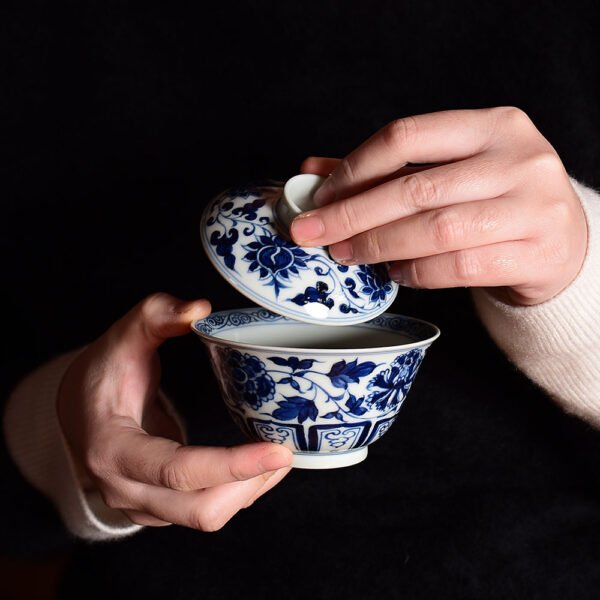 From: $989.98
From: $989.98The style of this super beautiful Gaiwan is Ming, using the underglaze blue technique, and entirely handcrafted and hand painted. The pattern features the classic design of intertwining Peony branches.
Peony, one of the beloved traditional patterns in our country, holds a special place in the hearts of the Chinese people with its lush and vibrant appearance and striking colors. As a symbol of our national spirit, it embodies the beautiful aspirations and good wishes for life, symbolizing the prosperity and longevity of the Chinese nation, with a history that stretches far into the past. The intertwined peony, known as “Wanshou Teng” or “Peony with Entwined Branches,” is a traditional auspicious pattern, that represents joyous occasions. Its continuous interlocking structure also conveys the meaning of “endless vitality” or “continuous growth.”
In addition, the beautiful tin spots on the porcelain add even more unique charm to it. The formation of tin spots is due to the high content of iron elements in local parts of the blue pigment. After reaching saturation in the high-temperature glaze solution and cooling down, the iron elements in the supersaturated part start to precipitate. If the iron content of the blue pigment is higher and the cooling rate is appropriate, tin spots are more likely to appear on the surface of the ware.
In addition to firing and materials, the formation of tin spots also involves the factor of glaze material. During the painting process, tin spots can also be formed due to the accumulation of blue pigment. Tin spots are more likely to appear on the surface of the ware at the intersections and the starting and ending points of brushstrokes. The formation of tin spots can be said to be a natural creation or an artificial decoration. This tin glazes not only add a rustic texture to the Gaiwan but also imbue it with a unique sense of history.
This Gaiwan exudes a charming style reminiscent of imitating the essence of Yuan Dynasty tea sets.
This tea set includes:
-
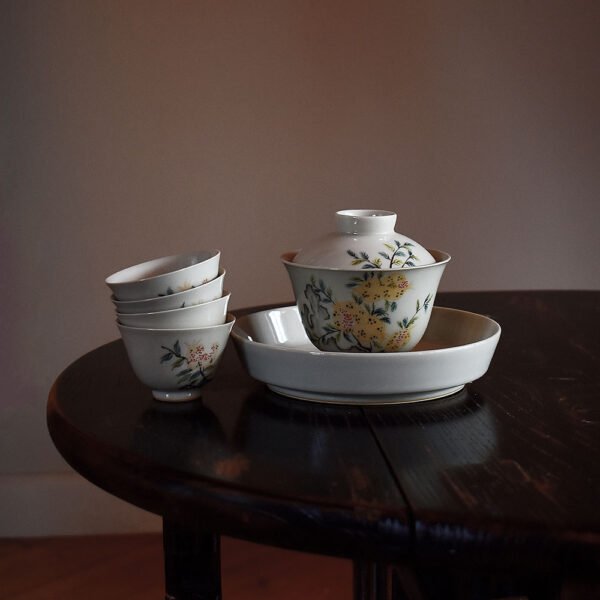
 $345.99
$345.99This tea set is made with antique clay glaze, which gives it a smooth and lustrous surface, as well as a thick and sturdy body, evoking a sense of ancient elegance, tranquillity, and warmth. The hand-painted strokes are lively and natural, depicting the pomegranate with lifelike accuracy.
Furthermore, the Gaiwan is crafted using the overglaze colour painting craft, which produces pure, vibrant, and full colours. Since Gaiwan is hand-painted by an artist, every piece is unique and machine-printed decals cannot be compared with.
-
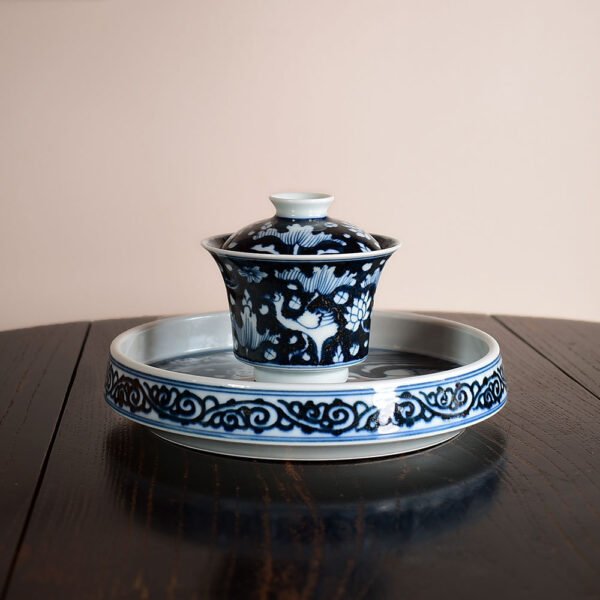
 From: $559.98
From: $559.98This tea set is made in the style of the Yuan dynasty blue and white porcelain, completely handmade and hand-painted. The pattern of “一鹭莲科” or “一路连科” in Chinese culture is derived from the beautiful combination of the heron and lotus leaves. As “鹭” (heron) and “路” (path/road) have the same pronunciation, and “莲” (lotus) sounds like “连” (successive/continuous), the name “一路连科” is a play on words that conveys the beautiful meaning of the pattern. In ancient times, successive successful candidates in the imperial examinations were called “连科,” and “一路连科” is a good wish for students to have a smooth career path and achieve success step by step.
For Yuan blue and white porcelain refers to the blue and white porcelain produced during the Yuan dynasty (1271-1368) in China. The Yuan dynasty was an important period in the history of Chinese porcelain and one of the peaks of Chinese porcelain art. As one of the representatives of that era, Yuan blue and white porcelain exhibited unique artistic styles and technical levels. The characteristic of Yuan blue and white is the use of cobalt blue pigment for painting, which is made of cobalt oxide. After firing, the colour is bright and rich, with an extremely high decorative effect. Yuan blue and white porcelain has various shapes, thick and heavy, concise, and fluent lines, and stable and solemn shapes, all made exquisitely.
The evolution of Yuan blue and white is based on the foundation of Tang and Song celadon. Firstly, the glaze colour was improved and innovated. Unique white glaze, eggshell glaze and blue-white glaze were invented to make the glaze crystal clear. Cobalt pigment was imported for glaze colouring. Or using the pigment made from domestic materials.
The formation of tin spots on Yuan blue and white is due to the high content of iron elements in local parts of the blue pigment. After reaching saturation in the high-temperature glaze solution and cooling down, the iron elements in the supersaturated part start to precipitate. If the iron content of the blue pigment is higher and the cooling rate is appropriate, tin spots are more likely to appear on the surface of the ware.
In addition to firing and materials, the formation of tin spots also involves the factor of glaze material. During the painting process, tin spots can also be formed due to the accumulation of blue pigment. Tin spots are more likely to appear on the surface of the ware at the intersections and the starting and ending points of brushstrokes. The formation of tin spots can be said to be a natural creation or an artificial decoration.
This tea set has a thick body and uses the Su Ma Li Qing glaze material (a kind of blue pigment), with a heavy sense of tin spots, revealing a unique charm of the past era. The entire production process is completed by hand, and every detail has been carefully designed and polished, giving this tea set a unique artistic charm.
This tea set includes:
-
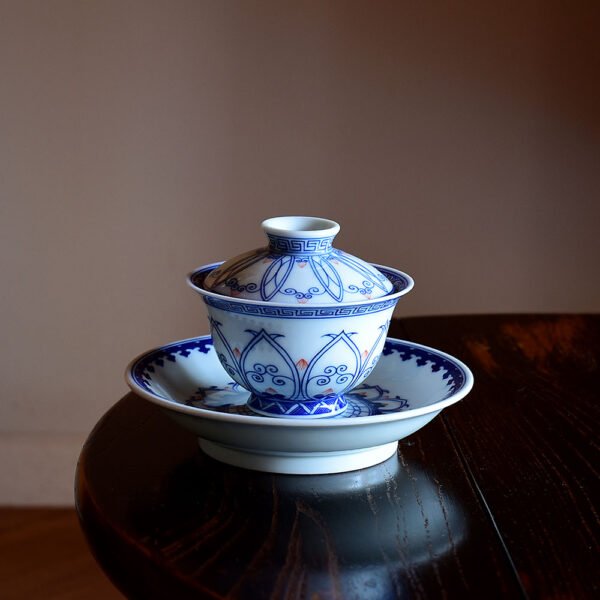
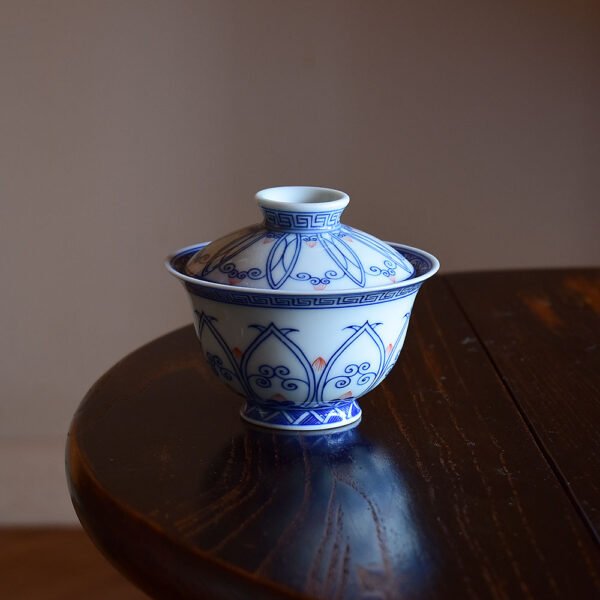 From: $489.98
From: $489.98This tea set is completely handmade and hand-painted. The special craft used in this teaware includes Blue and white underglaze colour and underglaze red.
The pattern featured is called “Bao Xiang” in Chinese, which is a traditional decorative motif representing one of the auspicious three treasures (Bao Xiang flower, Money tree, and Treasure basin), prevalent during the Sui and Tang dynasties in China. Bao Xiang pattern is also known as ‘Bao Xian Hua’ or ‘Bao Lian Hua’. Its lines are clear, and the colour is serene and antique. The Bao Xiang pattern design of this teaware is neat, and complex but not messy, and the whole picture of it is full and rich in details.
In Chinese culture, the Bao Xiang pattern symbolizes auspiciousness and happiness, representing people’s aspirations for happiness. It is widely popular in the decoration of silk brocade, bronze mirrors, and porcelain, showcasing people’s pursuit of a better life.
This tea set features smooth and concise curves, combining the unique beauty of the Bao Xiang pattern, creating a visually appealing and enjoyable tea-drinking experience. The blue and red underglaze colours complement each other and create a beautiful radiance.
This tea set includes:
-
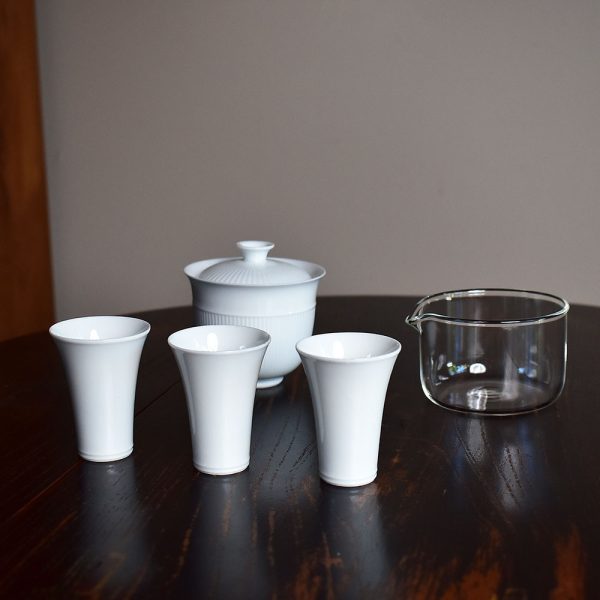
 $119.99
$119.99This Jun Zi’s White Porcelain Tea Set is crafted from smooth, delicate white porcelain, featuring a minimalist yet elegant design that exudes the dignified aura of a true gentleman. The set includes a gaiwan, three tasting cups, and a glass fair cup, seamlessly blending functionality with aesthetics to create a tranquil and refined tea-drinking experience.
Design Highlights:
- Smooth White Porcelain: The entire set is made from high-quality white porcelain with a lustrous and fine glaze, offering a smooth and jade-like touch that reflects an elegant and graceful temperament.
- Textured Detailing: The Gaiwan and teacups feature subtly embossed vertical lines, adding depth to the design while enhancing grip comfort.
- Elegant Proportions: The teacups have a slightly tapered waist, with smooth, flowing curves and a refined, tall silhouette that adds a ceremonial touch to every tea session.
- Transparent Fair Cup: The glass fair cup allows for a clear appreciation of the tea’s color, creating a visual contrast with the porcelain pieces and enhancing the overall aesthetic appeal.
- Premium Gift Packaging: The set comes in an exquisite gift box for easy storage, making it a sophisticated tea gift for friends and family.
The Jun Zi White Porcelain Tea Set is perfect for personal tea sessions or for elevating the ambiance of a formal tea gathering. The pure, elegant white porcelain beautifully complements the clarity of the tea, making every sip a serene and refined experience.
-

 $418.99
$418.99This Blue and White Landscape Gaiwan is handcrafted using traditional blue and white porcelain techniques, showcasing the elegant style of traditional Chinese landscape painting. The gaiwan features intricate landscape scenes, depicting bridges, mountains, rivers, trees, pavilions, and figures, creating a sense of tranquility and timelessness. The blue glaze varies in intensity, creating depth and dimension, capturing both the grandeur of the landscape and the finer details. The blue and white patterns on the tea set harmonize with the tea when poured, enhancing the tea-drinking experience.
Design and Appearance:
- Shape: The gaiwan has a classic shape with smooth lines, offering a comfortable grip and adhering to the traditional design of tea ware.
- Pattern: The hand-painted blue and white landscape pattern on the gaiwan is exquisitely detailed, showcasing the artist’s superior craftsmanship, especially in the depiction of rocks and trees, giving a three-dimensional effect.
Craftsmanship and Techniques:
- Blue and White Technique: This gaiwan is crafted using traditional blue and white porcelain techniques. The blue pigment fuses with the porcelain at high temperatures, resulting in a bright and stable glaze that is resistant to fading. The blue hue exudes a delicate tone under light, appearing particularly fresh and vibrant.
- Hand-Painted: The entire piece is hand-painted by skilled artisans, with each stroke infused with artistic expression, reflecting the artist’s profound understanding of traditional landscape aesthetics. Hand-painting ensures that each tea set is unique, with subtle differences that express the individuality and emotion of the artist. This handcrafted warmth and uniqueness cannot be matched by mass-produced items.
The Blue and White Landscape tea set is not just a functional utensil but also a symbol of traditional Chinese culture and art. It embodies the Chinese love for nature, the pursuit of art, and the appreciation of life aesthetics. Using such a tea set is not only about enjoying the flavor of the tea but also about savoring a cultural experience and lifestyle.
Custom Packaging Available
Want your gifts to reflect your brand’s personality? We offer custom packaging options including branded gift boxes, personalised cards, and curated themes to suit your style. Need something more specific than the options above? Just reach out — our team is happy to work with you on a bespoke solution that makes every gift feel truly special.
To get started, simply email us at [email protected] with details like the quantity needed, your budget, and any specific ideas you have in mind.
Feel free to browse our previous packaging solutions below to see how we’ve helped other businesses make a lasting impression.
Gift with Intention. Grow with Hey China.
FAQs
When are corporate gifts of Chinese tea appropriate?
Gifts of Chinese tea are a thoughtful way to celebrate a variety of occasions. They are perfect for holidays like Chinese New Year, as well as Australian holidays like Christmas and Easter. They also make a great choice for honouring work anniversaries, retirements, or simply as a token of thanks for a job well done.
Can I place a bulk order for my company?
Yes, we offer complimentary bulk delivery directly to your office for orders of 10 or more gift sets.
Can you add our company logo to the packaging?
Absolutely. We can incorporate your corporate logo on the gift box, on the outer packaging, and on select tea merchandise.
Is it possible to include our logo on the message cards?
Yes. You can easily add your logo to our “Congratulations,” “Welcome,” and “Thank You” message card templates.
Where do you deliver?
We deliver to personal residences and offices Australia-wide. Since each of our tea gift sets is made to order, please allow a couple of weeks for production and transit time for delivery.
Are receipts included in the gift box?
No, receipts are never included. As the purchaser, you’ll receive an email confirmation that serves as your receipt. If you need anything else, just contact us, and we’ll be happy to help.
Can I track my corporate gift order?
Yes. You will receive an email with a tracking number for all deliveries, allowing you to monitor the status of your order.







